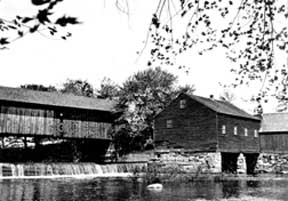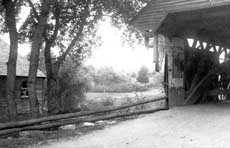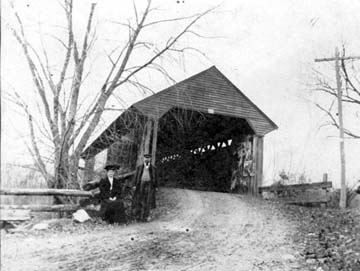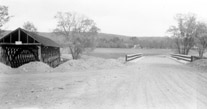THE BRIDGE AT SHORT FALLS
The following is from the 25th Aniversary Issue of : Covered Bridge Topics by the National Society for the Preservation of Covered Bridges, Inc. Vol. XXV, No. 1 - April 1967, and can be found in the Epsom Historical Association books by Phil Yeaton and available through the Epsom Historical Association.
 "According
to the Journal of the House of Provincial Legislature, in 1744,
a 'Canterbury Petition' lists the first bridge built in Epsom
and known as the 'Old Canterbury Bridge,' as being constructed
over the Big Suncook river. Note is also makde in 1758 that
Nathan Marden, the Town Clerk of Epsom, recorded in the old
Epsom Record Book that Captains Andrew McClary and John Clark,together
with Joshua Cery (Seavey?), were appointed to survey and plan
for a highway from Nottingham to Chichester.
"According
to the Journal of the House of Provincial Legislature, in 1744,
a 'Canterbury Petition' lists the first bridge built in Epsom
and known as the 'Old Canterbury Bridge,' as being constructed
over the Big Suncook river. Note is also makde in 1758 that
Nathan Marden, the Town Clerk of Epsom, recorded in the old
Epsom Record Book that Captains Andrew McClary and John Clark,together
with Joshua Cery (Seavey?), were appointed to survey and plan
for a highway from Nottingham to Chichester.
The next recorded entry in the Historical Sketch of Epsom, New Hampshhre, relates that John Tripp built a dam and saw mill at Short Falls about 1786, using the timber they cut in their mill. Later, another mill was built below the dam, to make paper and in later years cotton batting. This mill was burned in 1839, when both the grist mill and dam were rebuilt by another company. Reconstructed after deterioration, the mill had a most successful carreer, with farmers traveling thirty miles to bring their grain to be ground there. In 1927 there were still two grist mills in operation in the town.
 Another
bridge was built at Short Falls over the Big Suncook River on
the date of August 22, 1791. Workmen were paid three shillings
a day with the Selectmen authorized to furnish the thirsty workmen
with such quantities of rum as they felt would be necessary
to be expended in finishing this bridge. The record further
states that timber and labor, along with the necessary amount
of rum to rebuild the Short Falls Bridge came to $112.67.
Another
bridge was built at Short Falls over the Big Suncook River on
the date of August 22, 1791. Workmen were paid three shillings
a day with the Selectmen authorized to furnish the thirsty workmen
with such quantities of rum as they felt would be necessary
to be expended in finishing this bridge. The record further
states that timber and labor, along with the necessary amount
of rum to rebuild the Short Falls Bridge came to $112.67.
Through the years traffic demands necessitated many repair jobs - with complete rebuilding being undertaken in 1831. Mr. George Yeaton, Selectman of Short Falls, verified this date, with the State Department of Public Works, giving the information that removal took place in 1948. The steel bridge which replaced the picturesque covered span was erected in 1950. [note from Phil Yeaton -"I don't believe that my father was the selectman from Short Falls, maybe it was Russell Yeaton. However, Dad would have been able to verify the dates with the Highway Department as he forked for them at the time."]
When the covered bridge was dismantled in 1948, the good boards were taken and used to brace up the other covered wooded bridges that were still in existence in Short Falls and nearby townships.
According tot he research of Mrs. Madge Pierce, the covered bridge and Grist Mill were constructed in 1791. All available records of construction of the first covered bridge in the United States points to the year 1805 - the Permanent Bridge over the Schuykill River in Philadelphia, Pennsylvania. Covered bridge historians have long felt that this year marked the beginning of covered bridge building in this country."
FROM "Who Remembers Short Falls?" - NH Profiles magazine April 1976
 "Covered
bridges and grist mills were once common all over New Hampshire,
though only a few of each remain today. It was unusual to have
two of these landmarks side by side, so when such pairs did
exist, they quickly became popular stops for photographers.
One of the better known of these scenic spots was once in Short
Falls, part of the town of Epsom. Today little remains of the
bridge and the grist mill at Short Falls, but their story has
been preserved in the notes of Russell S. Yeaton.
"Covered
bridges and grist mills were once common all over New Hampshire,
though only a few of each remain today. It was unusual to have
two of these landmarks side by side, so when such pairs did
exist, they quickly became popular stops for photographers.
One of the better known of these scenic spots was once in Short
Falls, part of the town of Epsom. Today little remains of the
bridge and the grist mill at Short Falls, but their story has
been preserved in the notes of Russell S. Yeaton.
Yeaton was an alumnus of the University of New Hampshire, a dairy farmer and holder of numerous town and county offices. He was also the last man to operate the Short Falls grist mill. His property was near that on which the bridge was built, and he had crossed it many times. It was his prudence and imagination that saved it in the spring floods of 1937. And it was his foresight that saved the story of the bridge - and of the mill - for future generations.
Before his death in 1974, Yeaton compiled detailed notes on both the bridge and the mill. According to those notes, the bridge was probably built in the 1830's. Its abutments were of split granite (that is , quarried without the use of explosives), which supported a latticework structure about 110 or 115 feet long. When the bridge was less than three quarters of a century old, in 1893 or '94, ice coming down river during flood season snapped the tips off the lattice work. Russell Yeaton's father, Samuel Roby Yeaton, was road agent at the time, and he reinforced the structure with wooded arches. The value of this precaution would not become fully apparent for another 50 years!
During the disastrous spring flood of 1937, immense ice floes again came downstream, jamming up against the bridge, flooding its floor and preventing passage acorss it. All traffic between the village of Short Falls and Route 28 had to detour around the site. But the bridge withstood the diege, thanks to the ingenuity of Russell Yeaton. Recognizing the potential catastrophe ahead, he and seen to it that the bridge was supported in the crisis by actually chaining it to ancient and sturdy trees on both banks of the stream. The stout chains, coupled with the arches Russell's father had added, preserved the bridge.
 It
was not until the 1950's, when a new bridge was built downstream,
that the covered bridge at Short Falls was destroyed. At that
time, some feared that the eventual collapse of the old structure
would threaten the new one downstream. There are others who
found the destruction of the old bridge an irreparable loss.
It
was not until the 1950's, when a new bridge was built downstream,
that the covered bridge at Short Falls was destroyed. At that
time, some feared that the eventual collapse of the old structure
would threaten the new one downstream. There are others who
found the destruction of the old bridge an irreparable loss.
For its true devotees, the Short Falls covered bridge never died. It has appeared in numerous paintings, on locally sold stationary, in the pages of New Hampshire PROFILES and its predecessors, and in the listings of covered bridge fanciers' publications.
The grist mill was probably built about 1818, just as the grain growing period was beginning on New Hampshire farms. Dur9ing World War I, as farmers were starting to grow more wheat to compensate for existing shortages, the mill was reconditioned to grind more grain. When it became necessary to replace a pinion gear to one of the grinding stones at the same time, a new one was cast from the original pattern, which had been stored all that time in the Old Concord Foundry.
Even as late as 1920, the mill was a taxable property, which brought out a remarkable talent in a local tax collector.....After World War I, the mill was purchased by Suncook Mills, but it was not kept in repair and was eventually torn down. At the same time the new bridge was built, the dam and the mill's foundation were removed. Today all that remains are a few pictures, and for those who walked over the bridge to school or brought grain to the mill, many memories."
Top two photos - from Robert Yeaton Collection - bottom photo courtesy of Louise Dowst.